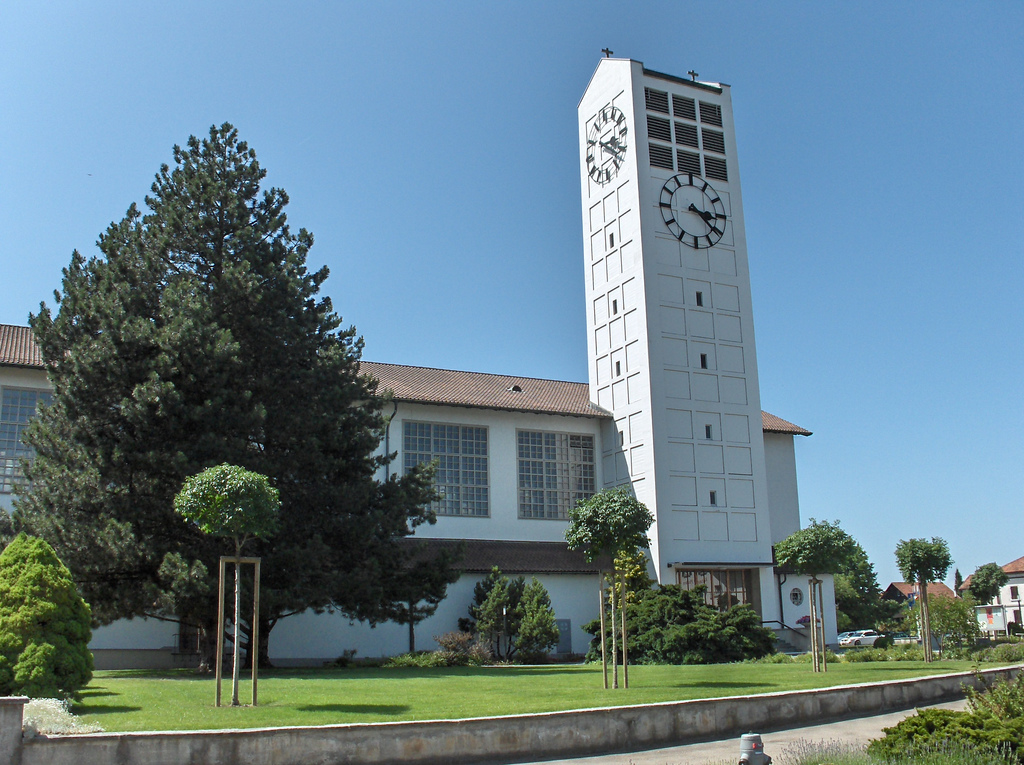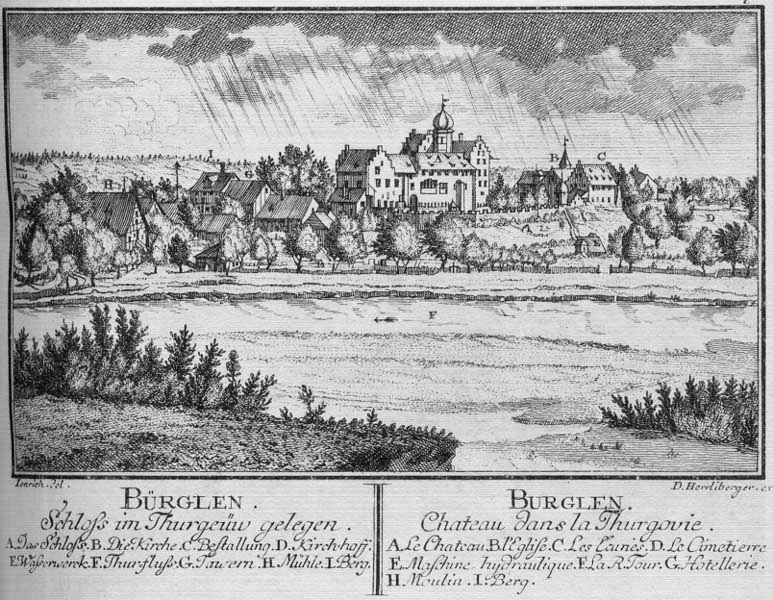|
Amriswil
Amriswil (Low Alemannic: ''Amerschwiil'') is a town and a municipality in Arbon District in the canton of Thurgau in Switzerland near the Lake Constance. The official language of Amriswil is (the Swiss variety of Standard) German, but the main spoken language is the local variant of the Alemannic Swiss German dialect. History Amriswil is first mentioned in 799 as ''Amalgeriswilare''. During the Middle Ages Amriswil and Brüschwil were part of a Bishop's fief. During the 15th Century, the Helmsdorf family ruled in Eppishausen. In the early 17th Century, the village of Amriswil was sold to Adam Tschudi of Glarus, and in 1665 the hospital was sold to St. Gallen. The court rights over Amriswil, Hölzli, Brüschwil and houses in Ruti and Giezenhaus were acquired by the city of Bürglen, which was under the control of the city of St. Gallen. This situation remained unchanged until 1798. In the mid-14th Century, chapel dedicated to Mary, was built in Amriswil. This ... [...More Info...] [...Related Items...] OR: [Wikipedia] [Google] [Baidu] |
List Of Towns In Switzerland
Below is a list of towns and cities in Switzerland. Until 2014 municipalities with more than 10,000 inhabitants were considered to be towns (german: Stadt/Städte, french: ville(s), it, città). Since 2014, the Federal Statistical Office (FSO) uses a new algorithm (called german: Statistische Städte 2012, or french: Villes statistiques 2012) to define whether a municipality can be called a town or not; it now also depends on its character. Currently, FSO considers 162 municipalities as towns/cities (german: Statistische Städte, french: Villes statistiques) in Switzerland. Further, some municipalities which would fulfill such a definition nevertheless prefer to understand themselves still as a village, or consequently refer to themselves just as municipalities (german: Gemeinde, french: commune, it, comune). The Swiss definition of a town differs from the definition of a municipality. List of towns and cities This is an alphabetical list of towns or cities (these English ter ... [...More Info...] [...Related Items...] OR: [Wikipedia] [Google] [Baidu] |
Arbon District
Arbon District is one of the five districts of the canton of Thurgau in Switzerland. It has a population of (as of ). Its capital is the town of Arbon Arbon is a historic town and a municipality and district capital of the district of Arbon in the canton of Thurgau in Switzerland. Arbon is located on the southern shore of Lake Constance, on a railway line between Konstanz/ Romanshorn and Ror .... The district contains the following municipalities: References {{Coord, 47, 31, N, 9, 26, E, source:eowiki_region:CH, display=title Districts of Thurgau ... [...More Info...] [...Related Items...] OR: [Wikipedia] [Google] [Baidu] |
Erlen
Erlen is a municipality in Weinfelden District in the canton of Thurgau in Switzerland. History The current municipality was formed in 1995 from the smaller communities of Erlen, Engishofen, Ennetaach, Kümmertshausen and Riedt.Amtliches Gemeindeverzeichnis der Schweiz published by the Swiss Federal Statistical Office accessed 14 January 2010 The section of Erlen known as Ehstegen was first mentioned in 838 as ''Escislec''. Before 1798 Erlen belonged in the so-called ''Hohen Gerichte'', which was directly under the authority of the governor of Thurgau. Eppishausen and a house in Erlen were ... [...More Info...] [...Related Items...] OR: [Wikipedia] [Google] [Baidu] |
Hefenhofen
Hefenhofen is a municipality in the district of Arbon in the canton of Thurgau in Switzerland. History Hefenhofen is first mentioned in 817 as ''Hebinhova''. Hefenhofen was a fief of the Abbey of Saint Gall and until the 17th century it was part of the Bailiwick of Hagenwil. In 1600, the low court of Hefenhofen was formed, which included Auenhofen, Hatswil, Moos and Tonhub. In 1644 the Lords of Bernhausen divided their lands, which included Hefenhofen. From 1644 until 1798 a number of different individuals owned the village. Since the Protestant Reformation Hefenhofen had belonged to the Reformed parish of Sommeri. In 1870, the political and geographic municipalities were merged into the combined municipality of Hefenhofen. In the 19th century the major economic activities included fruit production and weaving. Towards the end of the 19th century, this transitioned to cattle and dairy farming. In 1900 Hefenhofen included several farms and silk embroidery industry. The only hea ... [...More Info...] [...Related Items...] OR: [Wikipedia] [Google] [Baidu] |
Sommeri
Sommeri is a municipality in the district of Arbon in the canton of Thurgau in Switzerland. History In 1967, Sommeri was created when the municipalities of Niedersommeri and Obersommeri merged.Amtliches Gemeindeverzeichnis der Schweiz published by the Swiss Federal Statistical Office accessed 14 January 2010 Sommeri is first mentioned in 905 as ''Sumbrinaro''. Between 1474 and 1798, the ''eien'' of Niedersommeri and Obersommeri formed a court of the Prince-Abbot of |
Bürglen, Thurgau
Bürglen is a municipality in the district of Weinfelden in the canton of Thurgau in Switzerland. History Bürglen is first mentioned in 1282-84 as ''Burgelon''. A Freiherr of Bürglen is first mentioned in 1176. By 1350, the land around the village had all been brought under a single noble and became the '' Herrschaft'' of Bürglen. Then, in 1408, the ''Herrschaft'' was acquired by the Lords of Klingenberg. The land transferred in 1443 to Marquart Brisacher from Constance and then in 1447, it went to the Baron of Sax-Hohensax. That family had owned in property in Bürglen since 1360. By 1500 they had built it up to become the center of their power. However, in 1550 they had to sell it to the Breitenlandenberg family, who, in turn, ceded it in 1579 to the city of St. Gallen. The village was managed, until 1798, by a St. Gallen appointed Vogt. The ''Vogt'' ruled over the low court of Bürglen, Uerenbohl, Guntershausen (now Guntershausen bei Berg), Heldswil, Mettlen an ... [...More Info...] [...Related Items...] OR: [Wikipedia] [Google] [Baidu] |
Thurgau
Thurgau (; french: Thurgovie; it, Turgovia), anglicized as Thurgovia, more formally the Canton of Thurgau, is one of the 26 cantons forming the Swiss Confederation. It is composed of five districts and its capital is Frauenfeld. Thurgau is part of Eastern Switzerland. It is named for the river Thur, and the name ''Thurgovia'' was historically used for a larger area, including part of this river's basin upstream of the modern canton. The area of what is now Thurgau was acquired as subject territories by the cantons of the Old Swiss Confederacy from the mid 15th century. Thurgau was first declared a canton in its own right at the formation of the Helvetic Republic in 1798. The population, , is . In 2007, there were a total of 47,390 (or 19.9% of the population) who were resident foreigners. History In prehistoric times the lands of the canton were inhabited by people of the Pfyn culture along Lake Constance. During Roman times the canton was part of the province ''Raetia' ... [...More Info...] [...Related Items...] OR: [Wikipedia] [Google] [Baidu] |
Muolen
Muolen is a municipality in the ''Wahlkreis'' (constituency) of St. Gallen in the canton of St. Gallen in Switzerland. History Muolen is first mentioned in 1155 as ''Mola''. Geography Muolen has an area, , of . Of this area, 85.2% is used for agricultural purposes, while 7.7% is forested. Of the rest of the land, 7% is settled (buildings or roads) and the remainder (0.1%) is non-productive (rivers or lakes). The municipality is located in the St Gallen ''Wahlkreis.''. It is the northernmost municipality in the canton. It consists of the village of Muolen and multiple hamlets as well as part of the ''Hudelmoos'', the last high moorland in the ''Fürstenland'' (a historic region comprising the ''Wahlkreises'' of Wil, St. Gallen and Rorschach). Coat of arms The blazon of the municipal coat of arms is ''Per fess Or a Semi Mill-wheel Sable and vert a bar wavy Argent.'' Demographics Muolen has a population (as of ) of . , about 4.0% of the population was made up of foreign ... [...More Info...] [...Related Items...] OR: [Wikipedia] [Google] [Baidu] |
Salmsach
Salmsach is a municipality in the district of Arbon in the canton of Thurgau in Switzerland. History Salmsach is first mentioned in 1155 as ''Salmasa''. Salmsach was probably founded by the Bishop of Constance Salomo I who founded a religious community there. It was placed under the Abbey of St. Stephen in Constance by Salomo III in 910. In 1155 the abbey owned a farm, five ''Schupposen'', some tithe rights and half the church treasure in Salmsach. In 1380 it acquired at least the low justice rights as well. The Abbot of St. Gall, Ulrich Rösch, acquired Salmsach and the church treasure in 1471 and united it with the court of Romanshorn. They remained united until 1798. (to 1798). The Knights of the Churchyard of Arbon, who had entered into a contract in 1201 with provost and the Abbey of St. Stephen, were allowed to appoint the pastor and had other rights in the village. During the Protestant Reformation, Salmsach converted to the new religion. After 1588, the p ... [...More Info...] [...Related Items...] OR: [Wikipedia] [Google] [Baidu] |
Zihlschlacht-Sitterdorf
Zihlschlacht-Sitterdorf is a municipality in Weinfelden District in the canton of Thurgau in Switzerland. Geography Zihlschlacht-Sitterdorf has an area, , of . Of this area, or 73.6% is used for agricultural purposes, while or 15.9% is forested. Of the rest of the land, or 9.2% is settled (buildings or roads), or 1.1% is either rivers or lakes and or 0.1% is unproductive land.Swiss Federal Statistical Office-Land Use Statistics 2009 data accessed 25 March 2010 Of the built up area, industrial buildings made up 4.4% of the total area while housing and buildings made up 0.5% and transportation infrastructure made up 0.2%. while parks, green belts and sports fields made up 3.2%. Out of the forested land, 13.6% of the total land area is heavily fores ... [...More Info...] [...Related Items...] OR: [Wikipedia] [Google] [Baidu] |
Egnach
Egnach is a municipality of the district of Arbon in the canton of Thurgau in Switzerland. History Egnach is first mentioned in 1155 as ''Egena''. By the 9th Century it appears to have belonged to the Bishopric of Constance and was part of the upper Bailiwick of Arbon. The Abbey of Saint Gall acquired land in Egnach, which led to competing legal claims between abbot and bishop (which were settled in 854). During the Late Middle Ages it was a regional administrative center for lands of the Bishops of Constance. After the conquest of Thurgau by the Swiss Confederation in 1460, the new rulers replaced all the Bishop's representatives. While the low courts remained in the hands of the bishop until 1798, in 1509 he lost the rights to the high courts to the governor of Thurgau. In 1544 Egnach received a special lower court. The village was part of parish of Arbon. In 1515 St James Chapel was built in Erdhausen, and after 1588 Reformed religious services were held in that chap ... [...More Info...] [...Related Items...] OR: [Wikipedia] [Google] [Baidu] |
Mary (mother Of Jesus)
Mary; arc, ܡܪܝܡ, translit=Mariam; ar, مريم, translit=Maryam; grc, Μαρία, translit=María; la, Maria; cop, Ⲙⲁⲣⲓⲁ, translit=Maria was a first-century Jews, Jewish woman of Nazareth, the wife of Saint Joseph, Joseph and the mother of Jesus. She is a central figure of Christianity, venerated under titles of Mary, various titles such as virgin or queen, many of them mentioned in the Litany of Loreto. The Eastern Orthodox Church, Eastern and Oriental Orthodox, Church of the East, Catholic, Anglican, and Lutheran churches believe that Mary, as mother of Jesus, is the Theotokos, Mother of God. Other Protestant views on Mary vary, with some holding her to have considerably lesser status. The New Testament of the Holy Bible, Bible provides the earliest documented references to Mary by name, mainly in the canonical Gospels. She is described as a young virgin who was chosen by God in Christianity, God to annunciation, conceive Jesus through the Holy Spirit ... [...More Info...] [...Related Items...] OR: [Wikipedia] [Google] [Baidu] |




